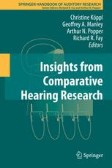Search
Search Results
-
Unveiling the neuroanatomy of Josephoartigasia monesi and the evolution of encephalization in caviomorph rodents
Caviomorph rodents are an exceptional model for studying the effects of ecological factors and size relations on brain evolution. These mammals are...

-
Endocranial asymmetry in New World monkeys: a comparative phylogenetic analysis of morphometric data
Brain lateralization is a widespread phenomenon although its expression across primates is still controversial due to the reduced number of species...

-
A Comparative Perspective on the Cerebello-Cerebral System and Its Link to Cognition
The longstanding idea that the cerebral cortex is the main neural correlate of human cognition can be elaborated by comparative analyses along the...
-
Three-Dimensional Visualisation of Skeletal Cavities
Bones contain spaces within them. The extraction and the analysis of those cavities are crucial in the study of bone tissue function and can inform...
-
The Origins of the Bird Brain: Multiple Pulses of Cerebral Expansion in Evolution
Birds demonstrate extraordinary cognitive and emotional capabilities. The majority of these performances are most likely supported by their developed...
-
Modern Imaging Techniques as a Window to Prehistoric Auditory Worlds
Direct evidence regarding the evolution of vertebrate hearing is available only through the examination of fossils. The fossilized bony anatomy of...
-

-

-

-
Neuromolecular computing: a new approach to human brain evolution
Evolutionary approaches in human cognitive neurobiology traditionally emphasize macroscopic structures. It may soon be possible to supplement these...
-
Evolution of the Mammalian Brain
It was apparent from the earliest sightings ofapes that a remarkable degree of resemblance exists between human and anthropoid forms (Fig. 2.1,...
-
Brain Size in Vertebrates
Humanity and human intelligence are considered to be derived from the large human brain; therefore brain size is regarded as a relevant and...
-
Mammals
“Intelligent activity may reasonably be regarded as the key note of mammalian progress” (Romer 1962). This progress became possible with the...
-
Brain Characteristics in Taxonomic Units
Insectivora are a heteromorphous order, some members of which seem to have departed less from the form of the generalized, primitive mammalian type,...
-
Fossil Evidence on the Evolution of the Neocortex
Yes, there is fossil evidence. That is the most surprising thing. The story the fossils tell is less surprising, because it is consistent with what...
-
Organization of the Cerebral Cortex in Monotremes and Marsupials
The view that monotreme, marsupial, and placental orders of mammals formed an orderly progression in mammalian evolution arose in the 19th Century....
-
Neurobiology of the Reptile—Bird Transition
Birds evolved from archosaurian reptiles during the Mesozoic era, between 230 and 65 million years ago. The archosaurs, or “ruling” reptiles,...
-
Why Does Cerebral Cortex Fissure and Fold?
The most striking, interesting, yet poorly understood gross morphological features of the cerebral hemispheres in mammals are the diverse and complex...
-
The Evolution of Intelligence: A Palaeontological Perspective
The main contribution of the fossil record concerning the evolution of intelligence, as I perceive it, is the time perspective: the time depth.
-
Evolution of Audiovocal Communication as Reflected by the Therapsid-Mammalian Transition and the Limbic Thalamocingulate Division
In the evolutionary transition from reptiles to mammals three key developments were (1) nursing, conjoined with maternal care, (2) audiovocal...
